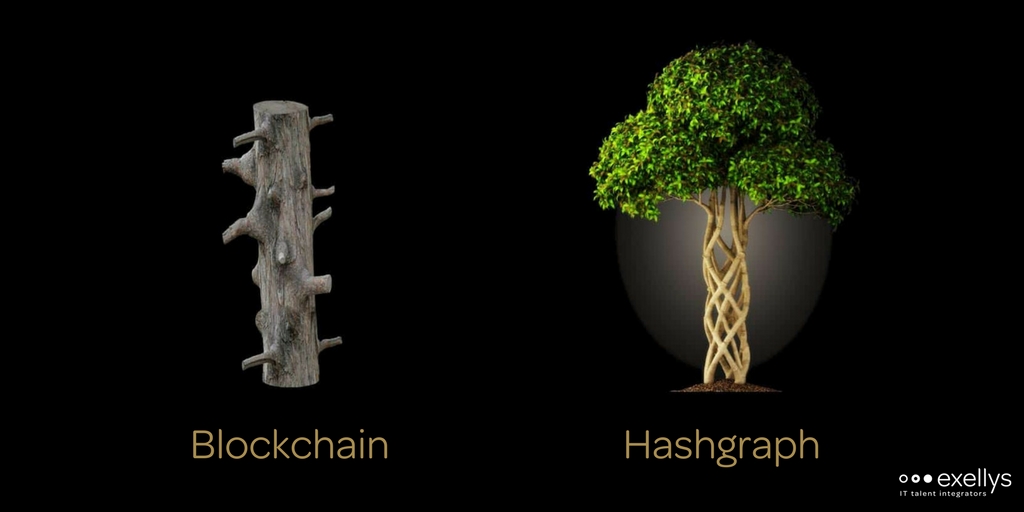Disrupting disruption: What the heck is a Hashgraph?
on 10 April 2018 for ProfessionalsThe low down on this new distributed ledger technology
In this post we’ll be talking about the Hashgraph, specifically:
- But why the Hashgraph?
- Is the Hashgraph better than Blockchain?
- How is the Hashgraph important?
- Background information about the Hashgraph TLD technology
- Gossip Protocols
- But what’s a voting protocol?
- Let’s have a quick recap
Let’s get to it.
But why the Hashgraph?
This post is building on our series on disruptive technologies because Exellys is all about disruption: we believe in the future, and in change.
It’s important to keep an eye on anything that might be the next big thing. That’s why we’d like to deep dive in the world of Hashgraph, a new and (apparently) improved version of Blockchain.
We will also be mentioning various terms specific to cryptographic technology. If you’re already finding this a bit over your head, check our list of resources at the end of the post for further reading. Be sure to also have a look at other articles in this series:
- The ultimate guide to finding a blockchain job in 2018
- 4 industries that will never be the same after blockchain
- Machine Learning is changing the world. This is how you stay ahead.
Onwards!
Is the Hashgraph better than Blockchain?
Hashgraph DLT technology is a superior consensus protocol with a unique data distribution structure. It may be a much better alternative to current blockchain technology. The project is still under development and there is no public version of it yet. There is also no crypto token or asset available. Nevertheless, it’s interesting to follow the development of this technology to see where it might lead, as there has been a lot of speculation about the future.

How is the Hashgraph important?
The Hashgraph is a new cryptographic technology created for the realization of distributed networks for payments, cryptocurrency and smart contracts. This technology works through the implementation of two different algorithms: a new Gossip Protocol in combination with a classic Voting Protocol.
The Hashgraph is a special alternative for chaining transaction blocks to a blockchain. It is a new superior technology for realizing a distributed database system or general ledger. This is also called Distributed Ledger Technology (DLT).
The Hashgraph DLT technology can replace the current blocking DLT technology in the near future – at least, that’s what everyone’s thinking. However, the inventor of this technology, Leemon Baird, has predicted that the Hashgraph’s own effects on networks will obstruct this replacement of technology, speaking especially about the Bitcoin network.
The Hashgraph DLT technology will probably first work complementarily and will be used especially for Internet of Things (IoT) applications. It will probably replace Ethereum and other smart contract platforms like it before it could replace the Bitcoin as digital gold.
It’s worth bearing in mind that all of this is still very speculative. Although the Hashgraph already works as a technology, it is still under development and it will take years before we can actually put the world economy on a foundation of this DLT technology.
These are indeed its ambitions though. For many reasons the blockchain technology of the Bitcoin is not capable of serving the whole world economy, and so the question is whether it will go with the Lightning network.
The Hashgraph would in this case compete with Bitcoin’s Lightning network.
In the video below we can see the inventor of the Hashgrap protcol, Leemon Baird, in an interview with Demitri Kofinas:
Background information about the Hashgraph DLT technology
The technological breakthrough of Bitcoin is based on the implementation of the Proof-of-Work algorithm and the Nakamoto Consensus Protocol.
This implementation creates an uncrackable distributed network where everyone can reach a consensus on the true state of the blockchain.
Yet, what most people do not realize is that the Byzantine Generals’ Problem is not really completely solved.
This is because it is more common for two different blocks to be simultaneously mined, creating a temporary fork or split, whereby the network will automatically determine which blockchain is the right one.
Then, among other things, the longest chain with the most computing power is looked at. This risk is also one of the reasons why the blocks follow each other rather slowly and have fairly long confirmation times.
This makes the Bitcoin blockchain indeed very safe and reliable, but slower and also expensive to maintain. It requires a huge infrastructure and electricity to keep the Bitcoin network in place for more and more users.
The Hashgraph consensus algorithm is radically different in that it is not a transaction block in a block chain. Hashgraph is about creating a distributed ledger, but not in the sense of a chain of transaction blocks.
You could argue that it is only a blockchain in the sense that the transaction chain is constantly forking.
In computer programming, a transaction usually means a sequence of information exchange and related work (such as database updating) that is treated as a unit for the purposes of satisfying a request and for ensuring database integrity (read more here).
A transaction is an information package that is called an event or occurrence. It is a broad definition since a transaction does not just have to be about a payment. A cryptocurrency is in fact only 1 application and application area of the distributed ledger technology. An event within the network can in fact represent everything.
Gossip protocols
All events are further communicated to the network with the help of what’s called a gossip protocol. Indeed, every node gossips away about everything it knows with another node. In this way, all information about all events is effectively super-fast.
In these snippets of gossip there is of course very accurate data such as the exact times and sources. It is gossiping about the gossip so that everyone ultimately knows everything about everyone! This is when a voting protocol is added.
But what’s a voting protocol?
A voting protocol is in fact a classic and super secure cryptographic algorithm with a development history of about 30 years.
Previously it was too slow to apply, but in combination with the new gossip protocol it works well when there is no need to vote specifically for each user of the network.
The protocol automatically calculates how each node (user) within the network will vote on the accurate status of the ledger, the Hashgraph.
Ultimately, consensus is reached on the basis of everyone’s voice, without it being necessary for a node to actually vote. How everyone votes is automatically calculated based on all the gossip and the gossip about the gossip about every event within the Hashgraph network. This way everything happens instantaneously.
With the current power of our chip technology, this gossip about gossiping and virtual voting is lightning fast. Below in the video you can see a video presentation on the operation of this new TLD technology:
A fascinating development in the world of crypto
- There is no public network available yet.
- The current technology is managed and also patented by the company Swirlds.
- There is also no crypto coin available yet.
- Questions about centralization and privacy issues remain open.
- No funding is requested and there is no ICO.
- This new TLD technology is just being worked on quietly by Swirlds.
At the moment, whether the Hashgraph actually has the potential to replace existing blockchain projects over time is still up in the air. As long as the technology is patented by the company and is not developed open-source, this cannot happen.
Theoretically and mathematically everything can be correct, but the practice is always volatile. Although theoretically Bitcoin cannot be possible, it does work and becomes stronger every year with more and more network effects.
Leeman Baird also recognizes this and realizes that the Hashgraph will not be able to compete in that area and that is why he also states that the Hashgraph does not have the ambition to replace existing blockchain projects … but he could be wrong.
Further reading
- The Future of Distributed Ledger Technology Is Not Blockchain. It’s Hedera Hashgraph | My Conversation with Leemon Baird
- AI 3.0: Why Hashgraph and how it will revolutionize Blockchain and AI
- Hashgraph wants to give you the benefits of blockchain without the limitations
- What is Hashgraph and How It’s Different From Blockchain
Over to us
As talent nurturers, we’re here to help you blossom into your best self. We bridge the gap between university and businesses by offering personal development and career coaching rather than simple headhunting.
Looking to find out more about what the Hashgraph can mean for your career or company? Contact us today.
Tags: blockchain , digitalization , hashgraph , innovation , techie



